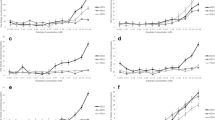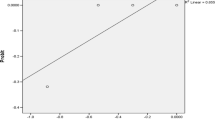Abstract
The measurement of acetylcholinesterase (AChE) activity is used worldwide as a biomarker of environmental contamination due to neurotoxic substances. In the present study the AChE activities was measured in marine snails (Cronia contracta) collected seasonally from six sampling sites (viz. Arambol, Anjuna, Dona Paula, Vasco, Velsao and Palolem) along the Goa coast during the pre-monsoon (April, 2004), monsoon (September, 2004) and post-monsoon (November, 2004) periods. The AChE activities in C. contracta showed wide variation along the Goa coast. It was found to be quite high at the reference site, Palolem (23.97, 21.72 and 24.85) throughout the sampling period (April–November, 2004). The AChE activities in C. contracta decreased significantly at Vasco (44.6–52.4% reduction) followed by Dona Paula (24.9–36.2% reduction), Velasao (10.8–35.9% reduction), Arambol (12.6–37.3% reduction) and Anjuna (0–12.7% reduction). Such a significant variation of AChE activities in the marine snail along the Goa coast can be attributed to neurotoxic substances prevalent in those regions. The high concentration of different neurotoxic metals (lead, cadmium, copper, manganese and iron) and petroleum hydrocarbons in the tissues of the marine snails at Dona Paula, Vasco and Velsao clearly substantiate reduction of AChE activities in C. contracta. The in vitro studies on the inhibition of AChE by different metals and PHC indicated that lead, cadmium and copper are the most predominant inhibitor. Based on the AChE activities in C. contracta the sampling sites along the Goa coast can be classified into three major clusters such as highly contaminated sites (Dona Paula, Vasco and Velsao), moderately contaminated sites (Arambol, Anjuna) and least contaminated site (Palolem).




Similar content being viewed by others
References
Binelli A, Ricciardi F, Riva C, Provini A (2005) Screening of POP pollution by AChE and EROD activities in Zebra mussels from the Italian Great Lakes. Chemosphere 61(8):1074–1082
Bocquené G, Roig A, Fournier D (1997) Cholinesterases from the common oyster (Crassostrea gigas): evidence for the presence of a soluble acetylcholinesterase insensitive to organophosphate and carbamate inhibitors. FEBS Lett 407(3):261–266
Cajaraville MP, Bebianno MJ, Blasco J, Porte C, Sarasquete C, Viarengo A (2000) The use of biomarkers to assess the impact of pollution in coastal environment of the Iberian Peninsula: a practical approach. Sci Total Environ 247:295–311
Escartin E, Porte C (1997) The use of cholinesterase and carboxylesterase activities from Mytilus galloprovincialis in pollution monitoring. Environ Toxicol Chem 16:2090–2095
Forget J, Beliaeff B, Bocquené G (2003) Acetylcholinesterase activity in copepods (Tigriopus brevicornis) from the Vilaine River estuary, France, as a biomarker of neurotoxic contaminants. Aquatic Toxicol 62(3):195–204
Galgani F, Bocquené G, Cadiou Y (1992) Evidence of variation in cholinesterase activity in fish along a pollution gradient in the North Sea. Mar Ecol Prog Ser 91:77–82
Lau PS, Wong HL, Garrigues Ph (2004) Seasonal variation in antioxidative responses and acetylcholinesterase activity in Perna viridis in eastern oceanic and western estuarine waters of Hong Kong. Continent Shelf Res 24(16):1969–1987
Lionetto MG, Caricato R, Giordano ME, Pascariello MF, Marinosci L, Schettino T (2003) Integrated use of biomarkers (acetylcholinesterase and antioxidant enzymes activities) in Mytilus galloprovincialis and Mullus barbatus in an Italian coastal marine area. Mar Pollut Bull 46(3):324–330
Lowry OH, Rosebrough NJ, Farr AL, Randall RJ (1951) Protein measurement with the Folin phenol reagent. J Biol Chem 193:265–275
Magni P, De Falco G, Falugi C, Franzoni M, Monteverde M, Perrone E, Sgro M, Bolognesi C (2005) Genotoxicity biomarkers and acetylcholinesterase activity in natural populations of Mytilus galloprovincialis along a pollution gradient in the Gulf of Oristano (Sardinia, western Mediterranean) Environ. Pollut. Elsevier, Press
Matozzo V, Tomei A, Marin MG (2005) Acetylcholinesterase as a biomarker of exposure to neurotoxic compounds in the clam Tapes philippinarum from the Lagoon of Venice. Mar Pollut Bull 50(12):1686–1693
Mmartinez Tabche L, Ramirez Mora B, German Faz C, Galar Castelan I, Madrigal Ortiz M, Ulloa Gonzalez V, Orozco-Flores M (1997) Toxic effect of sodium dodecylbenzenesulfonate, lead, petroleum, and their mixtures on the activity of acetylcholinesterase of Moina macropa in vitro. Environ Toxicol Water Qual 12:211–215
Pfeifer S, Doris S, Dippner JW (2005) Effect of temperature and salinity on acetylcholinesterase activity, a common pollution biomarker, in Mytilus sp. from the south-western Baltic Sea. J Exp Mar Biol Ecol 320(1):93–103
Sarkar A (1992) Evaluation of the toxicity of organic matter in marine sediments. Water Sci Technol 25(3):255–257
Sen Gupta R, Sarkar A, Kureishy TW (1991) Bio-degradation and anticholinesterase activity of methyl isocyanate in the aquatic environment of Bhopal. Water Res 25(2):179–183
Sturm A, da Silva de Assis HC, Hansen PD (1999) Cholinesterases of marine teleost fish: enzymological characterization and potential use in the monitoring of neurotoxic contamination. Mar Environ Res 47(4):389–398
Wells PG, Depledge MH, Butler JN, Manock JJ, Knap AH (2001) Rapid toxicity assessment and biomonitoring of marine contaminants—exploiting the potential of rapid biomarker assays and microscale toxicity tests. Mar Pollut Bull 42(10):799–804
Acknowledgment
The authors are thankful to Dr. S. R. Shetye, Director, NIO, Dr. M. D. Zingde, Dr. S. W. A. Naqvi and Dr. C. G. Naik for their constant encouragement and interest in this study. They also thank Mr. A. Mahale, Mr. R. Uchil and Mr. Sham Akerkar for their cooperation in computation of the sampling sites.
Author information
Authors and Affiliations
Corresponding author
Additional information
Special Issue on Biomarkers of Marine Pollution and Bioremediation
Rights and permissions
About this article
Cite this article
Gaitonde, D., Sarkar, A., Kaisary, S. et al. Acetylcholinesterase activities in marine snail (Cronia contracta) as a biomarker of neurotoxic contaminants along the Goa coast, West coast of India. Ecotoxicology 15, 353–358 (2006). https://doi.org/10.1007/s10646-006-0075-3
Accepted:
Published:
Issue Date:
DOI: https://doi.org/10.1007/s10646-006-0075-3




